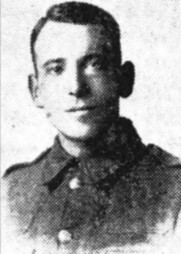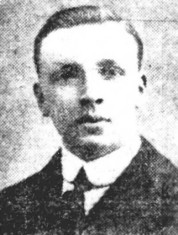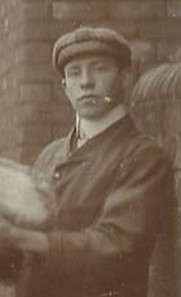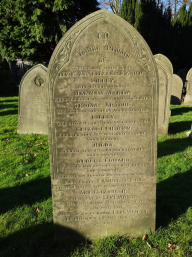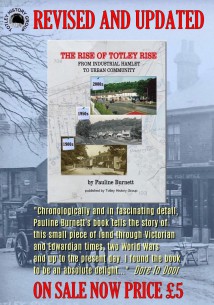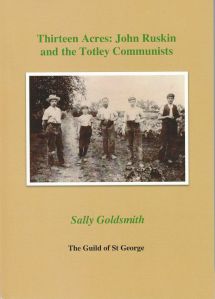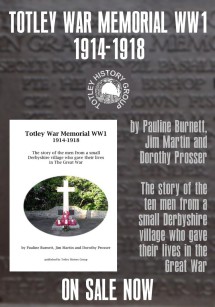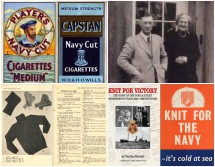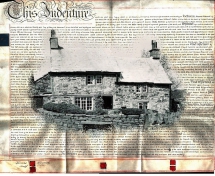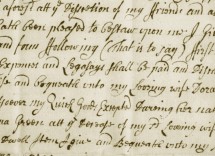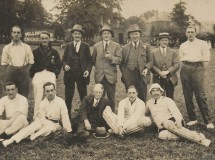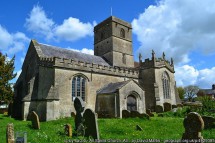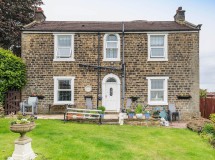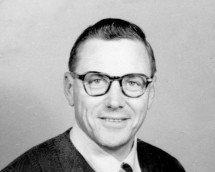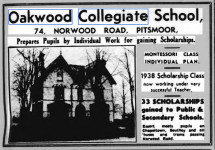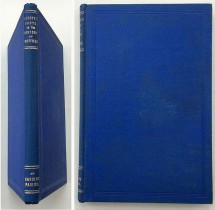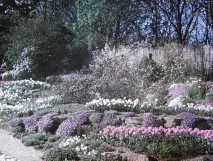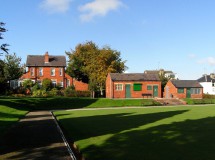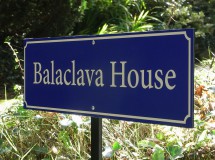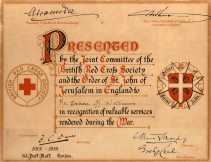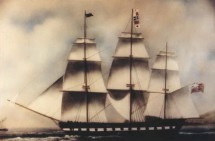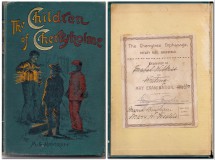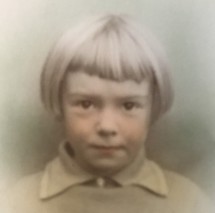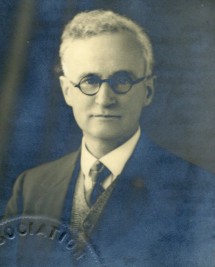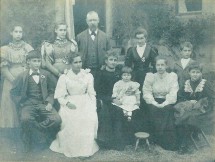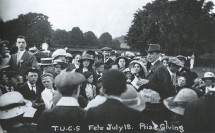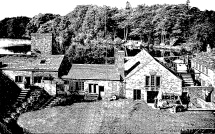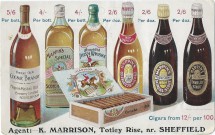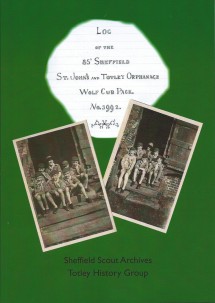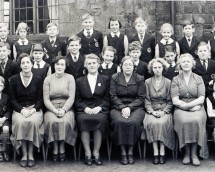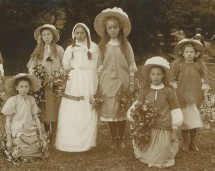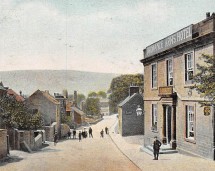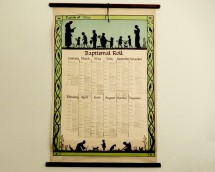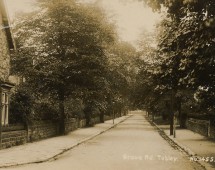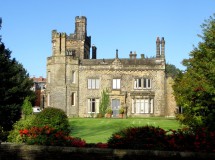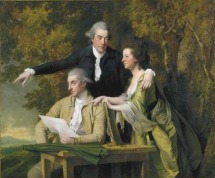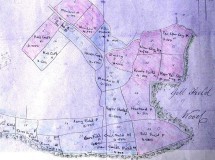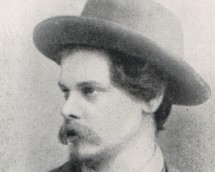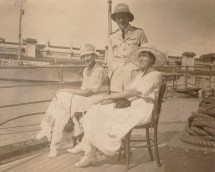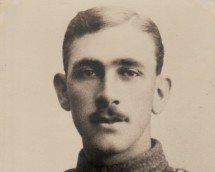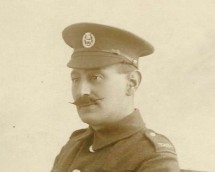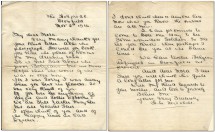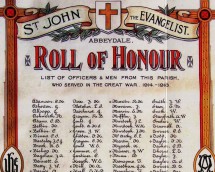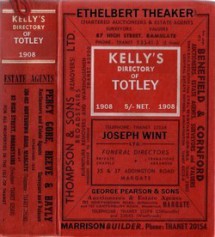WW1 Casualties S-Z
Harper Seed
Harper Seed was born in Sheffield in 1889, the middle child of three born to George Alfred Seed and his second wife Mary, nee Harper. He also had a half-brother and two half-sisters from his father's first marriage.
The family lived at Woodside, Abbeydale Road (South) before moving to Drayton House, 23 Devonshire Road (Mary was from Market Drayton, Shropshire). George was the managing director of John Hall and Sons, sugar merchants of Granville Hill, Sheffield and was well known in music circles in Sheffield and north Derbyshire as a choir conductor and baritone singer.
Harper inherited his father's musical talents. He was a fine pianist who had been successful at the Royal Academy of Music attaining the degree of A.R.A.M. He was also a composer whose work, it was said, showed originality and feeling. By 1911 he was described as a sub-professor at the Academy.
He joined Sheffield University Officer Training Corps and received his commission as 2nd Lieutenant, 17th Battalion of the Notts and Derby Regiment (the Sherwood Foresters) on 8 November 1915. He went to France in September 1916 and took part in much hard fighting on the Somme. The report from his commanding officer stated that he was killed on the 20 September "in the final stage of a big attack just as victory crowned his efforts. The men whom he led loved him". He had been the organiser of a popular concert party called The Tivolis and had only rejoined his battalion from leave in England a month before his death. He was aged 26.
Second Lieutenant Harper Seed is buried in the Dunhallow Advanced Dressing Station Military Cemetery, near Ypres, Belgium and is also remembered on the War Memorial Tablet in the entrance hall to Theatre Royal, Drury Lane. London.
James Talent
James Talent was born in Highfield, Sheffield on 6 April 1896 the fifth of nine children born to Walter Joseph Talent, a bolt and nut manufacturer and his wife Maud, nee Nowlin. The family were living at 40 Kearsley Road when James was baptized at St Barnabas Church on 22 April 1896 but had moved to 191 South View Road by 1901. The were living at 48 Thompson Road, close to the Botanical Gardens in 1911 but moved to Lingrow, 2 Busheywood Road before the war started.
James enlisted in the 8th Battalion, York and Lancaster Regiment at Pontefract on 7 December 1915. His training was done at Rugeley Camp, Cannock Chase, Staffordshire. On 27 May 1916 he sailed from Folkestone to Boulogne and reached his Battalion in the Somme on 23 June. On 1 July 1916 they were given the order to attack the German army near the village of Ovillers-la-Boiselle. Immediately after leaving the trenches they came under heavy machine gun fire and James was killed. He was aged 20. The 8th Battalion took 23 officers and 680 men into the attack that day of whom only 68 survived.
Private James Talent is buried at the Adanak Military Cemetery, Miraumont, France. His older brothers Walter (1888-1965), Harry (1891-1942) and Jack (1892-1956) all served their country in the Great War and are listed on the Roll of Honour inside St. John's Church.
John William Stone
John William Stone was born in Totley on 24 August 1892, the ninth of twelve children born to John William Stone senior and his wife Bertha nee Blackwell who had married at St. Lawrence Church, Eyam on 5 August 1877.
Their first child Mary was born in Eyam in 1878 but soon after they went to live in Curbar with John's parents, Rowland and Mary Stone. Further children followed: Eliza (1879), Joseph Blackwell (1881), Clara (1883), Annie (1884), Frances (1886) and Emma (1889).
John senior had been a stonemason until around 1885 when he became a gamekeeper employed by the Duke of Rutland on his Longshawe Estate. The Stone family moved to live at the the Duke's Bole Hill Lodge, Totley Bents in 1890. Four children were born in Totley: Martha (1890), John William (1892), Frederick (1894) and George (1897) and in all eight of the children attended Totley Church School, including John junior.
The Stone family then moved to Thickwood Lodge, the Duke's large hunting lodge at Owler Bar where their twelfth child Albert was born in 1900. Bertha Stones died there in September 1907 at the age of 50. She was buried at Eyam with Mary, her eldest daughter, who had died on 5 January 1899 at the age of 21. John senior had retired by the next census in 1911 and was living at Stanton Ford Farm, Curbar, with four of his children: John junior, Emma, Fred and Albert. Young John had become a farm labourer working on the Duke's estate.
On 10 February 1916 he joined the 2nd/6th Battalion (Sherwood Foresters) Nottinghamshire and Derbyshire Regiment and was stationed in Ireland during the Easter Rebellion of April 1916. Later he was sent to France and was killed in action on 27 April 1917 aged 24. Private John William Stone is buried at Templeux-le-Guerard British Cemetery, Somme, France and is commemorated on the war memorial at All Saints Church, Curbar. His effects were left to Elsie Gregory of Calver to whom he was engaged. Her older brother Walter married John's sister Emma in 1918.
Harold Todd
Harold Todd was born in 1891, the younger child of Thomas Wilkinson Todd and his first wife Annie Ada, nee Bell. His parents were natives of Bradford, West Yorkshire and had been living there with their one year old daughter, Louisa, in April 1891, but had moved to Sheffield by the time Harold was born later that year. Harold's mother died on 6 October 1900 and was buried at Christ Church, Dore.
In the census of the following year, the Todd family were living at Fairfield, Totley Rise (possibly 5 Glover Road) and Thomas had taken up a position as cashier for the Corporation Tramways. On 23 June 1903 he married Jessie Willis at Dore & Totley Union Church but further misfortune fell less than two year later when Jessie died. She was buried at Ecclesall on 15 March 1905.
In 1907 Harold's father married for a third time to Annie Ethel Bagshaw also at Dore & Totley Union Church where she was the accompanyist. Harold was educated at the Central Secondary School, Sheffield. By 1911 the family were living at Newlands, 22 Chatsworth Road and Harold had become a bank clerk with the London, City and Midland Bank in Church Street, Sheffield.
He enlisted on 11 September 1914 in the 12th Battalion (The Sheffield Pals) York and Lancaster Regiment. His first overseas posting was to Egypt to defend the Suez Canal. The 12th Battalion embarked aboard the HMT Nestor at Devonport on 20 December 1915 and arrived at Alexandria on 1 January 1916. The expected Turkish invasion failed to materialise and so on 10 March 1916 the Battalion left Port Said aboard HMT Briton bound for Marseilles, France on their way to join up with the British Expeditionary Force on the Somme. They travelled by train to Pont Remy, near Abbeville and then marched to Bertrancourt arriving on 29 March 1916. They went into the trenches a few days later.
On 4 May 1916 Harold received a slight wound to the leg which was attended to and he felt fit enough to make his own way to the rear. He stopped to talk to some friends in a dug-out when a shell burst close to them killing six men and wounding a further three. Harold was wounded again, this time more seriously. His wounds were again dressed as well could be done at the time and he was carried back to a dressing station where he died from loss of blood. Private Harold Todd was buried at the Sucrerie Miltary Cemetery, Colincamps, France.
Charles and Bernard Turner
This was the only Totley family to lose two sons during WW1, both in 1917.
Charles and Bernard were sons of Charles and Hannah Turner who lived in what is now the Old Orchard on Hillfoot Road. The house where the family lived for three generations was a small cottage and
still stands, although now part of a much larger property.
Their grandparents were Edward and Keturah Turner who married in the spring of 1849, Edward recorded as both agricultural worker and cordwainer (shoemaker), and Keturah as a laundress. Edward died in 1880 leaving Keturah with her daughter born prior to their marriage, and three other children, the youngest of which was Charles aged 15, known as Charlie, and who would become the father of Charles and Bernard who died in the war.
In 1881 Charlie was an errand boy but ten years later he was recorded as a scythe smith, a common trade in Totley as the mills on Old Hay Brook had been used for this purpose during the 19th century. However, by the end of the Victorian era these were becoming derelict or had been converted to farm use, so it was possible that he would have been working at Abbeydale Works, now the Hamlet.
In 1890 he married Hannah Bingham from Dore with Arthur, the first of their five children, being born in October of that year. There still exists an indenture dated 10 June 1895 in which Keturah gives the cottage and land to Charlie....
"in consideration of the natural love and affection of the said Keturah Turner for her son the said Charles Turner".
Hannah died in 1903 leaving her young family ranging from age 2 to 12, including Charles junior (aged 10), and Bernard (aged 5). She is buried at Christ Church, Dore. Their grandmother Keturah
lived on until 1907, dying at the age of 82.
Born on 16 August 1892, Charles Turner junior was at Totley All Saints School from September 1898 until leaving at the age of almost 13 to begin work. He is recorded as a scythe smith, like his
father, in the 1911 census and still living at home.
He enlisted in the Royal Marine Light Infantry as Private PO/1399(S), although his records are lost and dates unknown. He was killed on 17 February 1917, aged 24, on the western front south of Arras in France and is buried at Queens Cemetery Bucquoy in Grave Reference I.J.5.
Born in early January 1898, the school records for Bernard Turner have not been found but he is recorded in the 1911 census as a scholar. He is named as one of the children in the Pageant of King Ecgbert, performed in 1909, and written by Mrs Sarah Milner, the mother of Roy Denzil Pashley Milner, another of the men named on Totley War Memorial.
Bernard's service records have survived and give us details such as:
Date of enlistment-- 13 September at Chesterfield. Pte. No. 01896
Age-- 18 years 9 months
Height-- 5 ft 3 3/4 inches
Chest fully expanded-- 32 1/2 inches
Occupation-- wood working machinist
Regiment-- Royal Scots 2/8th Battalion
He was transferred to the 2/7th, and finally the 9th Battalion on arrival in Etaples, France on 25 June 1917. There is one entry in his records prior to being reported missing:
14 July 1917-- Deprived of 6 days pay for losing his rifle through neglect in the Field.
He was fighting in the Battle of Menin Road, near Ypres in Passchendale, when he was reported missing on 20 September 1917. His death was officially recorded on the 23rd with the War Office being informed the following day. He was 19 years old and is remembered at the New Irish Farm Cemetery, memorial reference XX.D.17.
It appears Bernard's body was found. In November 1921 his father received "2 discs and 1 numeral" which he was asked to acknowledge.
Arthur, Charles' and Bernard's eldest brother, also fought in WW1 and was taken prisoner of war but returned safely to live the rest of his life in the family cottage. He died in 1978 aged 88.
Their father Charlie died in 1944 having outlived three of his five children and is buried in Christ Church, Dore with his wife and daughter.
Robert Saxelby Vine
Robert Saxelby Vine was born in Sheffield on 5 March 1891, the only son of George Robert Vine junior and his wife Alice nee Saxelby who had married at the Zion Congregational Church, Sheffield on 29 March 1888. An older sister Edith died at home at 10 Ranby Road, Hunter's Bar on 13 February 1899 aged 10.
Robert's grandfather, George Robert Vine senior came to Sheffield in 1865 where he set up a business as a stay and crinoline maker and devoted his spare time to microscopic studies of the minerals and fossils of the local carboniferous deposits. He had 67 papers published in scientic journals and was a founder member and first president of the Sheffield Microscopical Society. His son and namesake became a teacher at the Carbrook and Darnall Schools before attending Glasgow University. He then took a B.Sc. degree at London University and became a class teacher at Sheffield Central Schools. Robert's father was appointed headmaster of the Hunter's Bar Schools and then, for 17 years until his retirement in 1923, headmaster of Huntsmen's Garden Schools in Attercliffe.
Young Robert was also academically bright and was awarded a bursary to Sheffield's Central Secondary School in 1905. He passed his matriculation examinations for Sheffield University in 1907 and obtained a Class II B.A. Degree with Honours in History in 1913. The following year he gained a Masters degree and was awarded the Gladstone prize in political economy. In September 1915, he was appointed to the staff of the Sir Andrew Judd Commercial School, Tonbridge, Kent.
Owing to defective eyesight he was three times refused admission to the Army but in December 1915 a fourth offer of service was accepted and he received a commission in the 1st Battalion of the Cambridgeshire Regiment. On Christmas Eve 1915 Robert married Elsie Palmer, the daughter of Mr and Mrs James Palmer of Fern Bank, at Dronfield Baptist Church.
Ordered to the front in August 1916 Robert spent only eight weeks in the trenches before being killed in action on 14 October. He was aged 25. Second Lieutenant Robert Saxelby Vine M.A. is commemorated on Pier and Face 16 B of the Thiepval Memorial, Somme, France. He is also remembered at the Judd School in Tonbridge and at Cemetery Road Baptist Church, Sheffield. At the start of the war Robert's parents lived at 27 Broomhall Place, Sheffield but later they moved to Inglewood, 40 Main Avenue, Totley.
Graham Stuart Ward
At recent Armistice Day services, a relative has placed placed small crosses on Totley War Memorial in memory of their ancestor who died in World War I. We thought we would see if we could find out more about him.
Graham Stuart Ward was born in Heeley on 30 March 1881, the youngest of twelve children born to William Ward and his wife Elizabeth (nee Blythman). Graham's father had a number of occupations including an iron and steel manufacturer's clerk and cashier before setting up business as William Ward and Company, umbrella rib manufacturers of Bernard Lane in the Park District of Sheffield. The family moved home location frequently but for much of the time that Graham lived in England the family were at 40 Oxford Street, Crookesmoor. There may be a connection with Dore and Totley as Graham's brother Norman married into the Fearnehough family in 1902.
When his father died in 1903 the umbrella business was sold. With all of his surviving siblings married or moved away, Graham sailed from Liverpool on 25 March 1903 aboard the Allan Line Numidian bound for Halifax, Nova Scotia with the intention of joining his brothers Frank and Edgar who had emigrated to Canada in April 1894. Their mother joined them there the following year accompanied by her niece Marguerite Marie Beecher. Graham's married sister Violet and brother Harold were soon to follow with their families. By the 1906 Census the Ward family were in Mackenzie, Saskatchewan and by 1911 they had moved to Humboldt in the same Province. Graham had become a farmer. His mother died on 26 October 1914 when the Wards were living at Hilliers Crossing, Vancouver Island, British Columbia.
On 17 September 1915 Graham signed attestation papers to join the Canadian Over-Seas Expeditionary Force. He belonged to the Active Militia but he had no previous military experience and was unmarried. He joined the 72nd Battalion, the Seaforth Highlanders, who embarked for Britain on 26 April 1916. They arrived in France on 13 August. They were drafted into the 16th Battalion of the Canadian Infantry on the Somme and Graham was reported killed in action on or around 4 September 1916, aged 35.
Private Graham Stuart Ward is buried in the London Cemetery Extension, High Wood, Longueval, France along with 3,871 other Commonwealth soldiers.
Frank Walter Warmsley
Frank Warmsley was born in Chesterfield on 2 February 1898, the only child of Walter Leonard Warmsley and his wife Agnes Ann, nee Seddon. Frank's father was the clerk, rate collector and assistant overseer for the Board of Guardians of the Ecclesall Bierlow Union (which included Dore & Totley) for over 35 years.
The family were living at 101 South View Crescent, Highfield in 1901 but had moved to 58 Everton Road, Endcliffe by 8 September 1903 when Frank was admitted to the infants department of Hunter's Bar School. He left the school on 15 May 1905 but no details are given of his later schooling. Frank became an employee of the Sheffield Banking Company, at first in George Street, Sheffield and later at their branch in Rotherham. The Warmsley family had moved home to Brentwood, King Ecgbert Road by 1916.
Frank joined the King's Liverpool (Scottish) Regiment as a private in August 1916 and went into training at Park Hall Camp, Oswestry, Shropshire. On 7 April 1917 her entered the 12th Cadet Officer's Training Battalion School at Newmarket, Suffolk, and on 10 August that year he obtained his commission and was transferred to the Sherwood Foresters (Notts and Derbys Regiment).
He left for France on 19 September and died on 22 November 1917 at No. 7 Casualty Clearing Station from a bullet wound he had received on returning from patrol. He was 19 years of age. Second Lieutenant Frank Walter Warmsley is buried at Noeux-les-Mines Communial Cemetery Extension, near Béthune, France.
Henry Edwards Wingfield
Henry Edwards Wingfield was born on 14 August 1896 in Crookes, Sheffield the only son from William Henry Wingfield's second marriage. His father had previously married Eliza Keyworth Gilson in Crookes in 1875 but she had died childless and been buried in Ecclesfield on 24 February 1890. Henry had four sisters from his father's second marriage to Louisa Ruth Edwards in Bexley, Kent in 1892.
William was a partner in the cutlery manufacturing business of Wade, Wingfield and Rowbotham of Tenter Street, Sheffield. The family had lived in Crookes and Woodhouse but when the business was taken over by Thomas Turner & Sons, William retired and the family moved to Devonshire Road, Dore. By the time of the 1911 Census the Wingfields were living at Brookside, 144 Totley Brook Road but Henry was away at boarding school in Southport, Lancashire; his aunt Sarah lived in nearby Birkdale.
Henry's father died on 12 March 1914 and was buried at Ecclesfield two days later. Henry's mother then took his sisters to live with their grandmother, Amelia Victoria Edwards, at Lullington Cottage, Bexley but Henry remained in Sheffield.
On 28 November 1914 he had attempted to enlist in the 4th (Hallamshire) Battalion of the York and Lancaster Regiment but was found to be under age and was discharged the following day. A week after reaching the age of 19, Henry signed attestation papers for the 12th Battalion, York and Lancaster Regiment in Sheffield. He was living at 76 Archer Road, Millhouses and had become an engineer's apprentice.
Henry was transferred to the 15th Battalion which on 5 April 1916 sailed to France to join the British Expeditionary Force. Henry was killed in action on 22 July later that year. We have been unable to find a report of how he died. Private Henry Edwards Wingfield is buried at Rue-du-Bacquerot No. 1 Military Cemetery, Laventie, France.
Selby Wolstenholme
Selby Wolstenholme was born in Totley on 25 January 1886, the only son of Selby Wolstenholme senior, a scythe smith at Totley Rolling Mill, and his first wife Rachel Moore nee Toulson who had married in Attercliffe on Christmas Eve 1882. Selby junior had an older sister Nellie who was born on 7 April 1883 but sadly his mother and his new born sister Sarah both died when he was aged just one. Rachel Wolstenholme was buried at Christ Church, Dore on 7 August 1887. She was aged 24. Strangely there is no mention of daughter Sarah in the Dore parish baptisms or burials.
In the 1891 Census Selby senior was still living at Totley Rolling Mill with his parents and daughter Nellie whilst his son was recorded as a "nurse child" of the Laws family who were their close neighbours. Selby junior was admitted to Totley Church School on 17 August 1891 aged 5 but unfortunately no date of leaving is recorded in the register.
His father married Mary Lowe at St. John's, Abbeydale on 20 November 1895. They had a daughter, Mabel, who was baptized at the same church on 15 March 1897. By 1900 they had moved to 63 Baslow Road, Totley Rise where Mary and Selby ran a drapery shop and the following year they took over the Post Office business which had been established a couple of years earlier at number 71. Young Selby became an apprentice butcher living with Colin Thompson at number 69.
On 2 November 1909 Selby junior married Nellie Sprentall at Rotherham Parish Church and soon after the couple moved to Dore to run a butcher's shop which Colin Thompson had established at Greenwood Mount. Selby enlisted in the 2nd Battalion (Sherwood Foresters) Notts and Derby Regiment. His service record unfortunately has not survived. What we know is that he served in France and Flanders and was reported wounded on 20 November 1917.
He rejoined his Battalion and was presumed to have been killed in action near St. Quentin between 17 and 19 September 1918. He was aged 32. Private Selby Wolstenholme is buried in the Chapelle British Cemetery at Holnon, France. He is also remembered on the family gravestone in Dore churchyard.
Samuel Wright was born in Totley in 1883, the tenth of fourteen children born to Levi Wright and his wife Ann Elizabeth, nee Pickering who had married in 1869.
At first they lived with Ann's widowed father Edward Pickering who farmed 23 acres at Piper House, Dore Moor. Levi was a coal miner like his father James Wright who had come to live at Dore after his marriage to Elizabeth Law in 1847. The couple had six children at Piper House: Elizabeth Ann (1870), Joseph (1871), Lilly (1872), Albert Edward (1873), Lucy (1875) and Clarissa (1876).
Following Edward Pickering's death in 1877, the farm stock, carts, equipment and house furnishings were put up for sale on 18 March 1878 and Levi, Ann and their five surviving children (Lilly died in her first year) moved to Totley Forge House, Oldhay. Three more children were born who died in their infancy, Hannah Maria (1878-79), Thomas Arthur (1880-80) and Lillie (1880-80) before Samuel Wright was born on 15 February 1883. Another four children were born subsequently: Ernest (1885), Hilda (1887-1890) Levi junior known as Jack (1888) and Gladys (1891).
In all nine of the children attended Totley Church School, Samuel being admitted on 29 September 1887 aged 4. By the time of the 1891 Census, Levi Wright senior had become a labourer in a brickyard, possibly at Moor Edge and Lucy and Joseph had left home. Elizabeth Ann died unmarried in 1893 aged 23. T
he 1901 Census records that the remaining six children were still living with the parents at Totley Forge. Their mother Ann was shown as a laundress so perhaps money was becoming tight for the Wright family. Ernest had become a filer in an engineers shop and Samuel, aged 18, was a joiner. Albert, who had become a railway labourer, died soon after in May 1901, the seventh of the Wright children to die.
Before the next Census in 1911 Samuel had emigrated to New Zealand. He joined the 4th Battalion New Zealand Rifle Brigade and fought on the Somme. Samuel was killed in action on 15 September 1916 in the Battle of Flers-Courcelette, when the village was entered by the New Zealand and 41st Divisions behind tanks, the innovative new weapons that were used here for the first time. He was aged 33.
Corporal Samuel Wright is buried at Bulls Road Cemetery, Flers, Somme. He is commemorated on the Auckland Museum Memorial and on the Wright family gravestone in Dore churchyard.
Search Our Website Here
September
October
November
Unless stated otherwise our meetings are held in Totley Library on the 4th Wednesday of each month at 7.30pm.
Pauline Burnett's book The Rise of Totley Rise has been revised and updated. It tells the story of this small piece of land from 1875 when there was only a rolling mill and chemical yard alongside the river a mile from Totley, through Victorian and Edwardian times, two world wars and up to the present day. It has 94 pages including a useful index and many illustrations from private collections. The book is available now from Totley Rise Post Office priced at £5, or through our website when an additional charge will be made to cover packing and postage.
A few copies are still available of Sally Goldsmith's book Thirteen Acres: John Ruskin and the Totley Communists. Totley was the site of a utopian scheme funded by art critic and social reformer John Ruskin. In 1877 he bought 13-acre St. George’s Farm so that nine Sheffield working men and their families could work the land and, to keep themselves busy, make boots and shoes. Sally tells an engaging story from our history with a quirky cast of characters including Ruskin himself, the poet and gay rights activist Edward Carpenter and Henry Swan, a cycling, vegetarian artist and Quaker. The book is available to order online from the The Guild of St. George by following this link.
A recently discovered box of WWII correspondence reveals the story of how a small group of ladies from Dore and Totley recruited knitters from the west of Sheffield and how their efforts made them the country's greatest provider of Comforts for the Minesweeping crews of the Royal Navy. The story is told in Knit For Victory, a new book from Totley History Group. Written by Pauline Burnett, it has 82 pages and many illustrations. It is on sale in local shops and via our website. Further information about the correspondence is in this inside page of our website: Dore & Totley Minesweeping Trawlers Comforts Fund.
The story is told in Totley War Memorial WW1 of the ten men from our village who gave their lives in the Great War. Written by Pauline Burnett, Jim Martin and Dorothy Prosser, a chapter is devoted to each of the soldiers with a family tree followed by as much information as could be discovered about the men and their families. There is also information about their military careers and the actions in which they lost their lives. The book has 64 pages and is illustrated throughout with photographs of the men, their families and the houses where they lived.
Totley All Saints' Church Parish Magazines for the years 1985-2006 with notices of baptisms, marriages and funerals and accounts of spiritual, educational, charitable and social matters in the village. Scanned in full, including advertisements from local traders.
In 1893 during the building of the Totley Tunnel there was an outbreak of smallpox amongst the navvies which spread to some of the local population. 17 people were buried in communal graves in Dore Churchyard, 6 from "Green Oak" (Lemont Road). The severity of the outbreak was principally caused by overcrowding and insanitary conditions in lodging houses .
Kathleen Grayson was a 39 year old housewife when WW2 broke out. She volunteered for the ARP and became an ambulance driver. During an air raid on Sheffield in July 1941, and despite her own injuries, she managed to get a seriously injured casualty to hospital. For this she was awarded a commendation from King George VI. Together with her friend Hilda Duffy, Kathleen also assembled a team of knitters to provide essential warm clothing for the men serving on the minesweepers patrolling the North Sea.
We have recently bought at auction the WW2 memorabilia of Douglas Platts whose family home was at Hillside, 98 Queen Victoria Road. After the war Douglas returned to his civilian occupation working in the family scissors manufacturing business. He lived in our area for the rest of his life.
We are very grateful to Mrs Valerie Taylor of Dore for lending us the title deeds to Lower Bents Farmhouse which is reputed to be the oldest surviving building in the area with a proven history back to 1621. We have now scanned and transcribed the deeds which could be particularly interesting to anyone with a connection to the local Fisher, Dalton and Marshall Families.
Until 1844, when Dore Christ Church parish was created, Totley township was part of Dronfield parish. We have now transcribed the burial records for former Totley residents at St. John the Baptist, Dronfield for the period 1678-1870 and at St. Swithin, Holmesfield for the period 1766-1901.
Whilst researching the history of the Dalton Family we found it useful to transcribe a number of early Wills and Inventories. These and those of many other Totley, Dore and Holmesfield people dating from between 1594 and 1856 have now been added to our website.
St. Swithin's Church, Holmesfield pre-dates Dore Christ Church and was the place where many of the people from Totley worshipped and were baptised, married and buried. Read the inscriptions on more than 750 gravestones in the churchyard including those of Mr. and Mrs. William Aldam Milner of Totley Hall, Jessie Matilda Tyzack (nee Fisher) of Avenue Farm, and Rev. J. A. Kerfoot of St. John's, Abbeydale.
Thomas Youdan was a music hall proprietor and benefactor who was living at Grove House, Totley in 1867 when he sponsored the first football knockout competition in the world for The Youdan Cup.
The words Millhouses Cricket Club can be seen in the background of team photos which are likely to date from between 1905 and the early 1920s, very probably pre-war. They were lent to us by Garth Inman who can identify his great uncle, Cecil Inman, in some of the photos and would like to know when they were taken and, if possible, the names of others present. Please take a look to see whether you can put names to any of the faces.
Josiah Hibberd was seriously injured whilst working on the construction of the Totley Tunnel in 1892. He died on 9 May 1897 at the age of 38 having apparently spent most of previous five years in hospital.
Bradway House was built around 1832 by Henry Greaves, a farmer, together with two adjacent cottages. We have traced most of the occupants of the property from these early days up to the start of World War Two.
We have transcribed the baptisms records at St. John the Evangelist, Abbeydale from when the church was consecrated in 1876 until just after the start of World War 1. The records are arranged in alphabetical order based upon the child's name and show the date of baptism, the names of the parents, their home location and occupation.
Nick Kuhn bought an original 1920s poster which had this owners' blind stamp in one corner. The stamp almost certainly refers to a house named Wigmore that was built in the late 1920s or early 1930s. The first occupiers that we can trace are John Howarth Caine, a district mineral agent for the LNER, his wife Florence Jane (nee Prince) and daughter Doris Mary. The Caine family lived at Wigmore until 1936 by which time the house would have been known simply as 12 The Quandrant.
George Griffiths died on 13 December 1888 following an explosion during the sinking of number 3 airshaft at Totley Bents. His widow Florence died shortly afterwards and his two daughters Maud and Annie were adopted separately. Whilst Annie lived the rest of her life in Yorkshire, Maud emigrated to Australia in 1923 with her husband, John Burrows, daughter Margaret and son Jack, pictured above.
George Wainwright was said to have been born in Bamford, Derbyshire in 1714. He learned the trade of linen weaving and moved to Totley after his marriage on 1744. He became an ardent follower of John Wesley who paid many visits to Sheffield and who would have passed through or close to Totley. Preaching was at first conducted out of doors and when Wesley's preachers became harassed by a mob of Totley ruffians in 1760, George offered them safety of his own home. He remained a Methodist for all of his long life, dying in Dore in 1821 at the reputed age of 107.
Oakwood School was started by Mrs Phoebe Holroyd in 1925 initially as the Firth Park Kindergarten and, by 1927, as the Firth Park Preparatory School. Phoebe was still working at the school almost fifty years later when she was well into her seventies. We would like to hear from anyone with memories of the school.
James Curtis was born at sea aboard HMS Chichester in 1790. He enlisted as a Private in the 1st Grenadier Regiment of Foot Guards in Sheffield in 1812 and served in Spain and Portugal during the Peninsular War. He later fought in France and Belgium taking part in the Battle of Waterloo. In later life James lived at the Cricket Inn where his son-in-law William Anthony was the licensed victualler. He died in Heeley in 1882 aged about 91.
Charles Paul lived in Totley in later life. He was a local historian and archaeologist who was an authority on the history of Sheffield, especially the two areas he knew best: Attercliffe and Ecclesall. His books and letters to local newspapers were published under the Latin form of his name Carolus Paulus.
Towards the end of the 19th century Totley Hall gardens became a well known beauty spot that attracted many hundreds of visitors from Sheffield on open days and the rock gardens became one of its most popular features. Mrs Annie Charlesworth sent us six glass transparencies of the rock gardens taken, we believe, in the early years following the Great War.
Anton Rodgers send us photographs of three water-colours that had been bought by his grandfather at a sale of the contents of Abbeydale Hall in 1919. One was of a scene said to be in York by A. Wilson. A second was of a seated child with a dog believed to be pianted by Juliana Russell (1841-1898). The third was of Lake Como, by Ainslie Hodson Bean (1851-1918) who lived for much of his life on the Riviera and in North Italy.
A Canadian correspondent sent us photographs of a set of silver spoons that were bought in a small town in British Columbia. The case contained a note signed by Ebenezer Hall indicating that they were a wedding gift to Maurice and Fanny Housley. We think we may have traced how they got to Canada and where they might have been since.
Green Oak Park was opened on 23 March 1929 on land that had been bought by Norton District Council from John Thomas Carr, a farmer and smallholder of Mona Villas. In later years, the buildings were used by the Bowling Club (the green having been built in 1956) and by the park keeper. However, the buildings appear to have been constructed in several phases, the oldest of which predates the park to the time when the land was used for pasture.
We believe the old Totley Police Station at 331 Baslow Road was built around 1882. Two lock-up cells were excavated just below floor level in the summer of 1890. We have traced the Derbyshire Constabulary police officers who lived there from John Burford in 1886 to George Thomas Wood who was there when Totley was absorbed into Sheffield in 1934.
David Stanley lived in Totley Rise in the later years of his life. Born in Bulwell, Nottinghamshire, he joined the 17th Lancers when he was 19 and rode in the Charge of The Light Brigade at the Battle of Balaclava where he was seriously wounded. For the first reunion of veterans in 1875, he told his story to a reporter from the Buxton Herald.
This picture postcard was addressed to Miss Abell, Holly Dene, Totley Brook Road and posted in Rotherham on 10 December 1907. Edith Annie Abell was born on 4 February 1887 in Sheffield and her family came to live in our area in the 1900s, staying for the rest of their lives.
Charles Herbert Nunn enlisted in the British Army on 23 August 1915 and was sent to France on 18 December 1915 to served with the British Expeditionary Force. In March 1916 it was discovered that he was underage and he was returned home. Shortly after his 18th birthday he re-enlisted and was again posted abroad where, in addition to this trio of medals, he was awarded the Military Medal.
This certificate was awarded jointly by the Red Cross and St. John's Ambulance to Isaac Henry Williams, of Lemont Road, for his services during WW1 as a stretcher bearer. We are seeking anyone who can help us pass it on to a living relative.
In 1832 Samuel Dean pleaded guilty to stealing a quantity of lead from the Totley Rolling Mill and was sentenced to seven years transportation to Australia. He sailed on the Mangles and upon arrival in New South Wales he was sent to work for William Cox, the famous English explorer and pioneer. After receiving his Certificate of Freedom in 1840, Samuel became a farmer and went on to have a very large family. Samuel was born in Whitechapel around 1811 to parents Samuel Dean Snr. and Susannah Duck. His descendant Sarah Dean would like help in tracing his ancestry.
Ellen Topham was born in 1889 in Nottingham. Her parents had been living together since 1862 but had never married so it was most unusual that, after their deaths, Ellen was accepted into Cherrytree Orphanage. Even more so since her father, Snowden Topham, had been acquitted somewhat unexpectedly in a widely reported manslaughter trial. Ellen remained at Cherrytree until her death from pulmonary tuberculosis at the age of 15.
Mabel Wilkes was a resident in Cherrytree Orphanage between 1897 and 1905. Her granddaughter Sally Knights sent us these images of a book presented to Mabel as a prize for her writing. Sally also sent us some personal memories of her grandmother and a photograph of a locket which contains portraits of Mabel and her husband Septimus Gale.
John Henry Manby Keighley was living at Avenue Farm when he enlisted in 1916. He fought in France with the Cheshire Regiment but after home leave in early 1918 he went missing. The Army were unable to determine whether he had deserted or returned to the front and been either killed or captured by the enemy. In August 1919 he was formally presumed killed in action but it appears he did not die but returned home to his family.
Horace Ford was admitted to Cherrytree Orphanage on 26 October 1888 at the age of six. He left at the age of 14 to become an apprentice blacksmith and farrier. Soon after his 18th birthday Horace enlisted in the Imperial Yeomanry to serve his country in the war in South Africa. His letter home to his Orphanage mentor tells of the lucky escape he had in battle.
Pat Skidmore (née Sampy) lived on Totley Brook Road from 1932 to 1948 before her family moved to Main Avenue. In this short article she remembers her time at Totley All Saints School where she was a contemporary of Eric Renshaw and Bob Carr.
As we have nowhere to exhibit memorabilia and artifacts, we have created a Virtual Museum instead. The latest addition to our collection is this double-sided Totley Rise Post Office oval illuminated sign which was on the wall of 67 Baslow Road before the Post Office business transferred to number 71. Please contact us by email if you have things that you own and would like to see added to the virtual museum.
Conway Plumbe was a man of many talents who came to live in Totley Rise around 1912. As a young man he had poems published by Punch magazine and is remembered in modern collections of WW1 poetry. A number of his paintings were accepted by the Royal Academy. An engineering graduate of London University, he joined the Civil Service where he rose to a high level as a factory inspector, publishing two books on the subject and giving a series of talks on workplace health and safety on BBC radio during WW2. In retirement he wrote a philosophical-spiritual work called Release From Time.
Inside Totley Rise Methodist Church there is a Roll of Honour commemorating the soldiers from its congregation who served their king and country during the Great War. For all but one of the 28 names the soldier's regiment is recorded in the next column. The exception is David Cockshott for whom 'killed in action' is written alongside yet he appears on no war memorial in our area and no record of a mortally wounded soldier of that name is to be found. We think we have solved the mystery.
Mrs. Kate Plumbe moved from Mansfield to Totley Rise with a number of her family in 1913 and became closely involved with the Totley Union Church. Her daughter Winifred became a missionary and headmistress in Calcutta for over 38 years following which she returned home to live with her sister Hilda on Furniss Avenue. Hilda had also been a teacher, missionary and, like her mother, a volunteer at St. John's VAD during WW1.
Thomas Glossop was a cutler and razor manufacturer who was well known amongst cricketing and gardening circles. Despite going blind, he was able to continue his hobbies with remarkable success
The Totley Union Cycling Society Prize Giving and Fete was held on the fields near Abbeydale Hall on 18 July 1914. Anne Rafferty and Gordon Wainwright have named some of the people in two wonderful photographs of the event. Can you identify any more for us?
The Tyzack family are well known in our area for owning iron and steel trades at Walk Mill, Abbeydale Works, Totley Rolling Mill and Totley Forge. This article covers the history of the family from the late 18th century when William Tyzack the founder of the company was born until the early 20th century when Joshua Tyzack farmed at Avenue Farm, Dore.
Walter Waller Marrison moved to Totley around 1897 with his wife and their two young sons. He was a house builder who constructed properties around Totley Brook and Greenoak before ill health forced him to take up less physically demanding work. In 1904 he took over the tenancy of the grocers and off licence at number 71 Baslow Road. After his death in 1908, his widow Kate and later their eldest son Jack continued to run the business until it was sold in 1934.
Ron Wijk of Nieuw-Vennep in the Netherlands has sent us two scanned images of drawings of old cottages made by the celebrated Dutch painter, Anton Pieck (1895-1987) simply annotated "Totley", and wondered whether we could identify their locations.
We would like to thank Christopher Rodgers for bringing to our attention this fascinating log of the 85th Sheffield (St. John's and Totley Orphanage) Wolf Cub Pack for 1927-45. The log is published jointly by Sheffield Scout Archives and Totley History Group as a free PDF download. It is illustrated by no fewer than 92 photographs and is supported by a comprehensive index and biographies of some of the main participants.
Following our Open Meeting event on School Days, Roger Hart, Howard Adams and John Timperley have each written to us with their memories of Norwood School, which was located in the rooms attached to the Dore & Totley United Reformed Church on Totley Brook Road.
On 22nd July 1909 the children of Dore and Totley Schools celebrated by a pageant the union of England under King Ecgbert which took place at Dore in AD 827. The pageant was devised and written by Mrs Sarah Milner and her daughter Marjorie and performed in a field close to Avenue Farm in front of a large audience. Photographs of the event survive together with a fragment of the script.
John Edward Greenwood Pinder had lived all 46 years of his life in Totley but on census night, Sunday 2 April 1911, he was not at home; he was in Derby Gaol serving a sentence of three months hard labour. From the age of 20, John had been in and out of local courts for a series of minor offences including drunkenness, assault, wilful damage and night poaching. Finally he was sent to gaol for cutting down and stealing 86 small trees which he sold in Sheffield market for Christmas.
We have already transcribed the census returns for Totley, Totley Rise and Dore. Now we have transcribed Census Strays. These are people who were born in Totley but are missing from our earlier transcriptions. They may have been living, working or studying elsewhere or just away from home on the night the census was taken. Two people were in prison. Others were in Union Workhouses, hospitals and asylums. Fully indexed strays from the 1851, 1861, 1881, 1891, 1901 and 1911 censuses are available now.
We wish to thank Gillian Walker for allowing us to digitize an archive of material about the 1st Totley Scout Group. Most of the material was collected by Arthur Percival Birley in the period 1949-51 and there are many interesting documents pertaining to the building of the scout hut on Totley Hall Lane. In addition four Newsletters survive, two from the 1940s and two from 1971.
We are grateful to Angela Waite and All Saints' Parish Church for giving us access to baptismal and kindergarten birthday rolls dating from 1926 to 1941. We have transcribed the names, addresses, birthdates and baptismal dates and created an alphabetical index of entries for you to search.
Edmund Sanderson, a Sheffield estate agent, aquired the land on either side of the old drive to Totley Grove in 1874 and divided it into plots for development. He called it the Totley Brook Estate. But before many houses were built, the estate road was severed in two by the building of the Dore & Chinley Railway line. The eastern end of the road became the cul-de-sac we now call Grove Road.
John Roberts was born in Sheffield in 1798. He became a partner in one of the leading silversmiths firms in the city before moving to Abbeydale Park in 1851 and extending the house in Victorian gothic style. He paid for the building of St. John's Church and was believed to dispense more in charity than any other person in the neighbourhood including his protege Ebenezer Hall.
The Coke Family owned the Totley Hall Estate from 1791 to 1881. With the aid of a family tree to guide us, Josie Dunsmore takes us through the story of their tenure.
When the Rev. D'Ewes Coke inherited the Totley Hall Estate in 1791 it had two farms. Josie Dunsmore tells the story of how the two farms were combined under the tenancy of Peter Flint with the aid of field maps drawn by Flint himself and later by the Fairbanks family.
Do you think you recognize this face? More than sixty photographs of the girls and teachers at Hurlfield Grammar School for Girls in the 1940s were given to Totley History Group by Avril Critchley, who was herself a student at the school. The collection includes fifteen form photographs from June 1949. There would have been a number of girls from the Totley area attending the school in those days.
Christine Weaving tells the story of her 2 x great uncle George Edward Hukin, a Totley razor-grinder, and his life-long friendship with the academic, poet, writer, and free-thinker Edward Carpenter.
Eric Renshaw (pictured here on the right with Bob Carr) grew up and lived in Totley from 1932 to 1960. Many of his memories are of a sporting nature.
We are very grateful to Gordon Grayson for giving us this splendid sale document for the Norton Hall Estates, following the death in 1850 of Samuel Shore. The estates included a large part of Totley and the document has maps and illustrations, plus schedules of land and property with the names of tenants. We have also added a transcription of the entries for Totley and Dore.
Watch this Youtube video of the talk given by Dr. Mark Frost and Sally Goldsmith on Ruskin, Totley and St. George's Farm. The talk was hosted by Totley History Group on 20th May 2015 as part of the Ruskin in Sheffield programme. Also enjoy a video of the outdoor performance Boots, Fresh Air & Ginger Beer written by Sally.
When Jacqueline A. Gibbons became interested in what made her father tick, it began a journey through WW1 archive records and led to her flying from Toronto to visit the house and village where he lived and the countryside that he so much enjoyed. Jacqueline reminds us that in the early 20th century Sheffield was a driving force of industry and that Totley was the place where many of its remarkable people lived and where they formulated their ideas.
Edgar Wood was the designer of The Dingle, 172 Prospect Road, built in 1904 for Rev. William Blackshaw, the founder of the Croft House Settlement. The house, together with its western terrace and boundary walls, has now been awarded Grade II listed building status.
What was probably "the most perfect little garden railway in existence" in 1910 was to be found in the grounds of Brook House, Grove Road, the home of its designer and constructor, Guy Mitchell. Look at some wonderful photographs and read reports in newspapers and a full appreciation in Model Railways magazine.
We have now completed our transcription of Totley School's Admission Records for the period from 1877 to 1914. There is also a useful index to the names of the scholars and to their parents or guardians. We are very grateful to Sheffield Archives and Local Studies Library for allowing us to transcribe and publish these records and for permission to reproduce the photograph of a specimen page of the register.
On 8, 9 and 11 November 2014 Totley History Group held an exhibition at Dore & Totley United Reformed Church to commemorate the centenary of the First World War. Below are additional links to some of the photographs we were lent and stories we researched especially for the exhibition.
Oscar Creswick was a local farmer who served with the Army Service Corps in Salonika and who after the war returned to Totley to become the innkeeper of the Cricket Inn and a member of the village's successful tug of war team.
Walter Evans was a market gardener who also ran a small grocery shop on Hillfoot Road when war broke out. He fought with the Machine Gun Corps at the fourth battle of Ypres. After the war, Walter ran a grocers shop at the top of Main Avenue.
Fred Cartwright was another Totley soldier who survived the Great War. He fought in France and Belgium and although he wasn't wounded he was gassed and was home on sick leave when his daughter was delivered by Nurse Jessop during a snowstorm in January 1917.
Maurice Johnson joined the Yorkshire Dragoons, a territorial unit, on 1 Jan 1914 and so was called up at the very start of the war. He fought throughout the war on the Somme, at Ypres and at Cambrai. After demobilization in 1919 Maurice returned to his old occupation in the steel industry.
Bill Glossop lent us a letter written by his father, William Walton Glossop to his wife describing life in the army during training in the north east of England and asking her to keep him in mind with the children.
The photo above provides a link to an album of photographs taken of WW1 Hospitals at St. John's, Abbeydale and the Longshaw Estate.
Nora Green, of Chapel Lane, was only 14 when war broke out. In 1914 she was ill with diphtheria and was sent to the isolation hospital at Holmley Lane, Dronfield. Nora recovered and wrote a letter of thanks to one of the hospital staff and the reply she received survives.
We have collected together on this page the names of local men who appear on various War Memorials and Rolls of Honour in Totley, Dore, Abbeydale, Norton, Holmesfield and Dronfield.
Unfortunately we were unable to identify all the photographs we were lent of Totley Soldiers. Please take a look at this album to see if you recognize any of the missing names.
This walk visits locations that have strong associations with Totley during the First World War. It includes the homes of the ten soldiers from the village who lost their lives, the auxiliary hospitals, war memorials, and even the rifle range on which the soldiers trained. Take a look at the first draft of a new walk by the authors of "Totley War Memorial WW1 1914-1918"
We wish to thank the Trustees of Cherrytree for giving us permission to publish transcriptions of the Cherrytree Orphanage Admissions Book entries for the years 1866-1929. There is also an alphabetical index for you to look at.
With more people having access to faster broadband and mobile networks, we have uploaded seven full and unedited oral history recordings and also added more short excerpts for you to listen to.
Our transcriptions of local trade directories have been expanded to cover the 95 years from 1837-1932 and have also been indexed. From the days when there were a handful of farmers, stone masons, saw handle makers & scythe grinders to the wonders of the Totley Bridge Garage Company, Betty's Boudoir and The Heatherfield Shopping Centre.
We continue to add to our Totley Newspaper Archive. Recent entries have included several about The Plumbe Family, Thomas Glossop and accidents during the construction of Totley Tunnel.
Totley Church of England Parish Magazines for the years 1922-1939 and 1948-1967 with notices of births, marriages and deaths and accounts of spiritual, educational, charitable and social matters in the village.
Around 90 photographs taken by Stuart Greenhoff for his thesis A Geographical Study of Dore and Totley including several of Totley Moor Brickworks. Superb!
Chronologically ordered snippets of information recorded by Brian Edwards during his many years of research into our local history.
Read the inscriptions on more than 700 gravestones in the churchyard.
Visitors since 24 Sep 2012:




